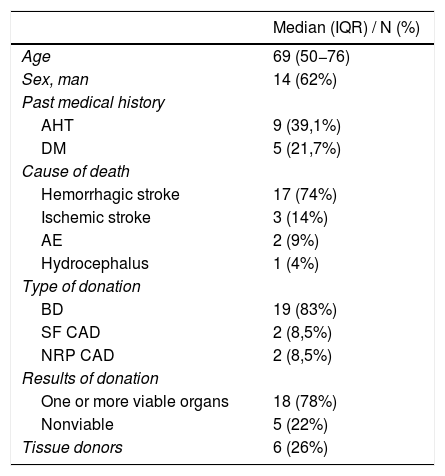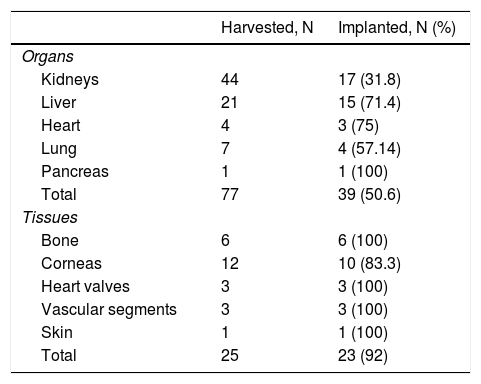Organ and tissue transplantation is currently a consolidated therapy that last year saved the lives or improved the quality of life of over 5300 patients in our country. However, yet despite this great activity, we are still not self-sufficient when it comes to meeting the needs of our population.1
In this sense, the National Transplant Organization (NTO) started a strategic plan to assess areas with room for improvement, set specific goals, and design specific actions.2,3 Among the limiting factors we constantly find the number and type of hospitals involved in the process of donation in such a way that transplant centers and centers with neurocritical patients traditionally have more activity.4 Over the last few years, the number of private hospitals has grown, they have become more complex, and gained prominence as part of the healthcare system with a huge number of human, material, and logistic resources.5
Considering the little involvement of the private sector in the activity of donation since 2012, the Sectorial Coordination of Transplants Seville-Huelva, Spain has signed a public-private collaboration agreement with several hospitals from the city of Seville, Spain to support the process of organ and tissue donation in the intensive care unit (ICU) setting without having to transfer the potential donor, thus guaranteeing that he can participate in this process. Also, added to a training program for the ICU and OR staff of the private sector.6–8
This program facilitated the option of organ and tissue donation from dead people in these centers who would have never been donors otherwise. After 7 years, we wish to present the results obtained to show the room for growth of a collaborative program like this.
This was an observational and retrospective study of the activity of organ and tissue donation in private hospitals of the city of Seville from 2012 through 2018. The sex, age, blood type, presence of cardiovascular risk factors like arterial hypertension or diabetes mellitus, as well as the cause of death of every donor were recorded. Also, the type of donation was specified whether under conditions of brain dead (BD) or controlled asystole donation (CAD), as well as the number and type of organs and tissues extracted. Finally, the organs that were eventually transplanted and those that were not viable for transplantation were identified, as well as the causes that prevented the transplant. Quantitative variables were expressed as median and interquartile range (IQR), and the qualitative ones as absolute numbers and percentages.
A total of 23 organ and tissue donors were registered. A total of 82% of the cases were donations under conditions of brain dead (BD) that were predominant within the first 4 years of the study. Over the last 2 years, donation in CAD has come up as the new model of donation, using the super-fast preservation technique in two cases, and the normothermic regional perfusion (NRP) technique in another two (Table 1).
Characteristics of donors.
| Median (IQR) / N (%) | |
|---|---|
| Age | 69 (50−76) |
| Sex, man | 14 (62%) |
| Past medical history | |
| AHT | 9 (39,1%) |
| DM | 5 (21,7%) |
| Cause of death | |
| Hemorrhagic stroke | 17 (74%) |
| Ischemic stroke | 3 (14%) |
| AE | 2 (9%) |
| Hydrocephalus | 1 (4%) |
| Type of donation | |
| BD | 19 (83%) |
| SF CAD | 2 (8,5%) |
| NRP CAD | 2 (8,5%) |
| Results of donation | |
| One or more viable organs | 18 (78%) |
| Nonviable | 5 (22%) |
| Tissue donors | 6 (26%) |
AE, anoxic encephalopathy; AHT, arterial hypertension; BD, brain death; DM, diabetes mellitus; NRP, normothermic regional perfusion; SF CAD: super-fast controlled asystole donation.
A total of 78% of the donors provided one or more viable organs for transplantation. A total of 39 organs were implanted, which represents a rate of 1.7 viable organs/donor with a distribution shown on Table 2. Only 5 cases provided nonviable organs being the most common cause of organ rejection for transplantation the unfavorable anatomopathological results obtained in the biopsy performed prior to implantation.
Organs and tissues harvested and implanted from 2012 through 2018.
| Harvested, N | Implanted, N (%) | |
|---|---|---|
| Organs | ||
| Kidneys | 44 | 17 (31.8) |
| Liver | 21 | 15 (71.4) |
| Heart | 4 | 3 (75) |
| Lung | 7 | 4 (57.14) |
| Pancreas | 1 | 1 (100) |
| Total | 77 | 39 (50.6) |
| Tissues | ||
| Bone | 6 | 6 (100) |
| Corneas | 12 | 10 (83.3) |
| Heart valves | 3 | 3 (100) |
| Vascular segments | 3 | 3 (100) |
| Skin | 1 | 1 (100) |
| Total | 25 | 23 (92) |
Since 2012, the involvement of the private sector healthcare system of the city of Seville is a reality with over 20 donors and nearly 40 organ transplants of solid organs. This commitment with donation and transplantation represents 3.5% of the activity performed in this sector increasing the rate of donors per million inhabitants (54.3%) above the Spanish mean rate.
If we compare our results with those presented by the NTO1 we’ll see that the median age of these donors and the most common cause of death (hemorrhagic stroke) exceed the Spanish median since private centers don’t usually admit polytraumatized or acute neurocritical patients who require invasive procedures. Regarding the different donation modalities available and, also consistent with the Spanish data, most donors died in situation of BD. In our series, CAD represents 20%–30% of the cases, meaning that Spain is a pioneer in the use of NRP.
Regarding the effectiveness of the process of organ donation, we can see that in this period, the rate of the private sector is lower compared to the Spanish one, which is probably due to the fact that they are elderly donors with more cardiovascular risk factors compared to the Spanish population. This last hypothesis is backed by the fact that most grafts (above all, renal grafts) were rejected by the anatomopathological findings of the biopsy.
Throughout this period, a total of 4 private hospitals have been accredited for organ and tissue harvesting, which brings extra quality to the services rendered to the users, and recognition to these centers as part of the Spanish healthcare network to the point that they have eventually been included in the assessment and quality framework of the Autonomous Regional Transplant Coordination in Andalusia, Spain.
The difficulty of healthcare systems worldwide to reach self-sufficiency in organ extraction for transplantation makes the coordination units of our country work on an ongoing basis looking for new strategies to optimize the process of organ and tissue donation.8–10
Taking all this into consideration and after reviewing our results, we conclude that the implementation of the process of organ and tissue donation in the ICU setting of the private sector should be an actual strategy aimed at transplant coordination of other sectors of our country and other parts of the world with the common goal of performing a larger number of transplants successfully.
In conclusion, we believe that taking donation to the private sector not only increases the rate of donations but should also be an obligation for all healthcare personnel who work at the ICU setting to give all citizens the opportunity to become organ and tissue donors regardless of the hospital selected.
Conflicts of interestNone reported.
Please cite this article as: Martín-Villen L, Ruiz de Azúa-López Z, Revuelto-Rey J, Aldabó-Pallás T, Alonso-Gil M, Egea-Guerrero JJ. Colaboración público-privada en Sevilla como estrategia para ampliar los donantes de órganos y tejidos: Think there is no box. Med Intensiva. 2022;46:103–105.






